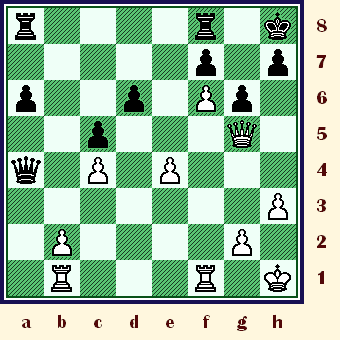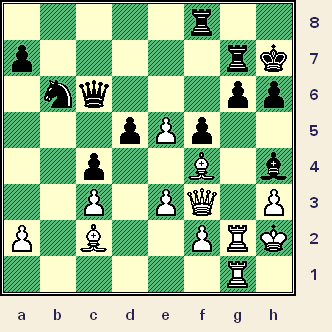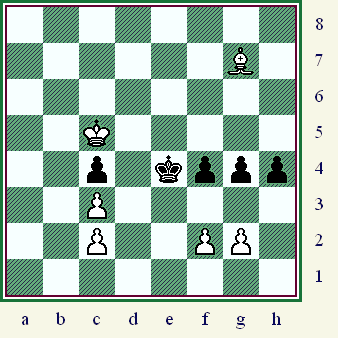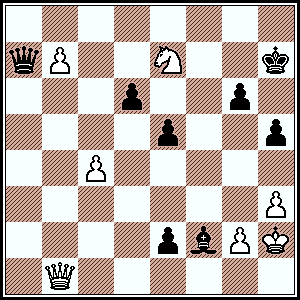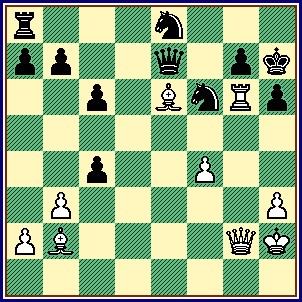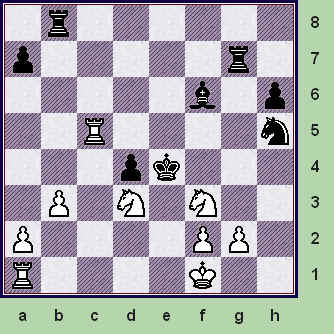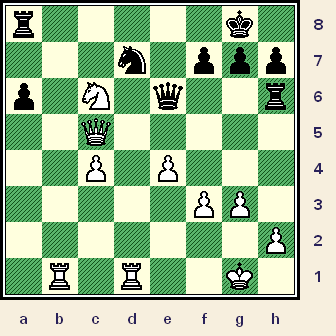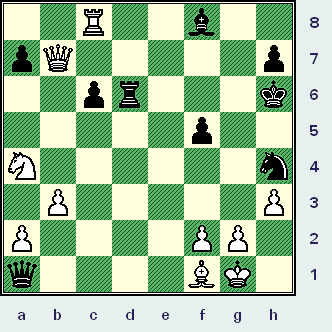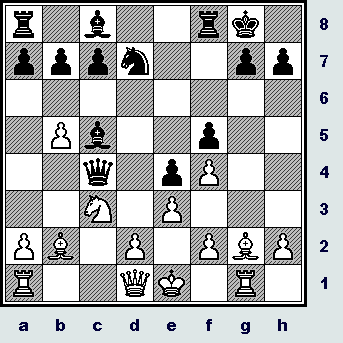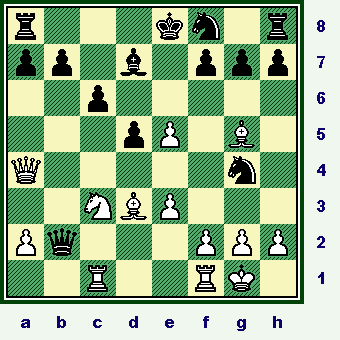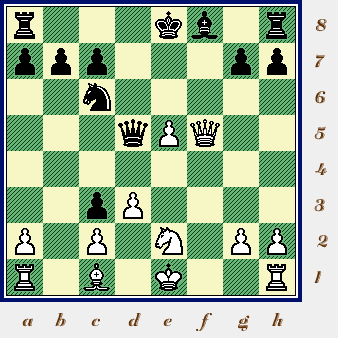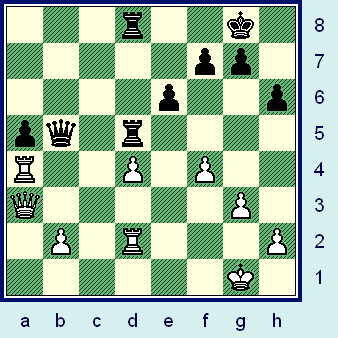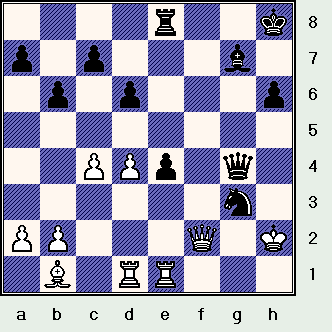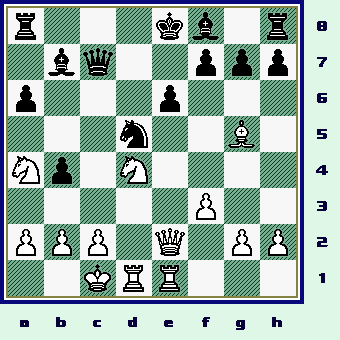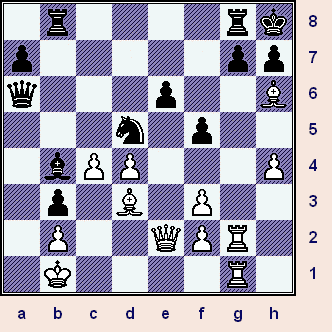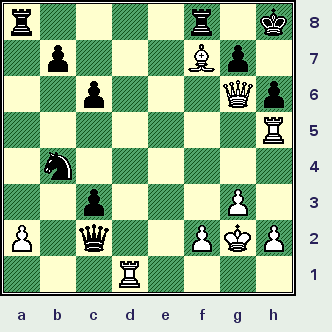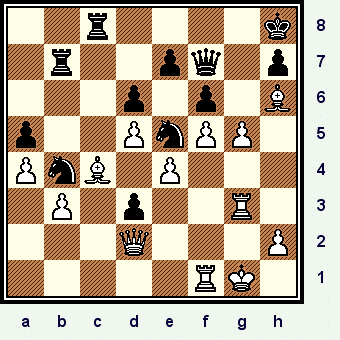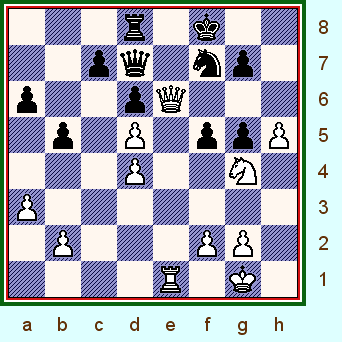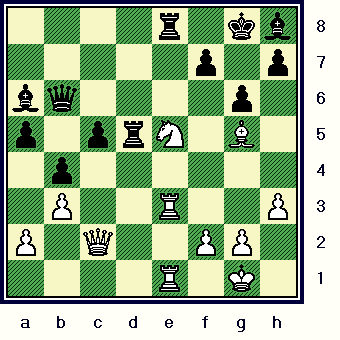All
the |
(Navigation bar
directly below.)
*******
© A.J. Goldsby, 2015.
(All rights reserved.)
****************
Click HERE
to see my
Chess Items.
****************
****************
Buy a book
from Amazon.com
(And help me out as well!)
****************
Click HERE
...
to see a list of the businesses that help to sponsor all of
my chess efforts.
A.J.'s Weekly Chess Puzzles (Solutions Page #2)
(All solutions for problems posted in 2005.)
This will be my page, (created in November, 2004); to permanently record all of my weekly chess problems. I will give the position, {a diagram}; a position check, {where all the pieces are} the participants in the game or who composed the problem, the source of the problem, etc. (All the pertinent and necessary information.)
Plus I will at least give the solution - maybe with some light analysis and explanation as well.
Don't expect me to give the solution before the next problem is posted ... it isn't going to happen!!
The diagrams on this page were all created with either Chess Captor 2.25 or ChessBase. (8.0 or 9.0)
*******
Please ... DO NOT send me any e-mails about this feature. Solve the problem, do it on your own. HAVE FUN WITH IT!!! I have more than enough books and stuff to provide the material for this feature. Please don't - send me your games!! No, no, no! Don't bother, OK?
If you are one of those individuals who used a computer to solve this, you need not ever tell me about it! (I especially don't want to hear from someone who used Fritz, and claims to have completed their analysis on their very own!!! Ugh! I would not believe you, anyway.)
Puzzle Number # 13; Thursday / January 13th, 2005.
White to move.
Position in Forsythe: (top-to-bottom/left-to-right) -
r4r1k/5p1p/p2p1Pp1/2p3Q1/q1P1P3/7P/1P4P1/1R3R1K
**********************************************************************
|
White to move in this position. ***************************************************** David Bronstein was {during the height of his best playing days} one of the greatest players of his era ... a great master in every phase of the game! He was {also} a superb attacking player - one of the most feared of that era of chess. How does he conclude this epic game? |
******************************************************************************
D. Bronstein
(2675) -
P. Keres
(2675)
Weekly Problem, January, 2005. Pensacola, FL
*********************
David Bronstein was one of the greatest players of his era. How does he conclude this epic game?
From the game:
GM David Bronstein - GM Paul Keres; (FIDE)
Candidates Tournament; (Round #18)
Budapest, Hungary; 1950.
How does White increase the pressure?
***************************************
The ratings here are simply estimates.
32.Rf4! Qc2; {Diagram?}
Black counter-attacks.
(I don't think it really matters what move Black chooses in this position.)
[ 32...Rfd8!? ]
Position # 267, page # 73;
The excellent little problem book:
"The Times Winning Moves," by GM R. Keene and Byron Jacobs.
<< David Bronstein was one of the most feared attacking players of his day.
How did he brilliantly conclude his K-side attack? >> - Raymond Keene
33.Qh6!!, ("+/-")
White threatens a mate, Black decides to quit - there is absolutely no defense here for Black.
[ The final moves would have been:
33.Qh6!! Qxb1+;
34.Kh2 Rg8;
35.Qxh7+! Kxh7; 36.Rh4#. ]
Copyright (c) A.J. Goldsby, 2005. All rights reserved.
1 - 0
Puzzle Number # 14 / Sunday; January 30th, 2005.
White to move.
Position in Forsythe: (top-to-bottom/left-to-right) -
5r2/p5rk/1nq3pp/3pPp2/2p2B1b/2P1PQ1P/P1B2PRK/6R1
**********************************************************************
|
Basically ... it is "White to move and win." (maybe) ******************************************* It is obvious that White has built up a very strong attacking position on the King-side. Can White make use of his possibilities here? Is there a good move or a breakthrough in this position? Or can Black defend this sad looking affair? |
******************************************************************************
O. Danielian
(2450) - K. Landa (2560)
[D03]
Weekly Problem, January,
2005. (# 02) Pensacola, FL
01,02,2005.
***********************************************************************
From: John Nunn's "Chess Puzzle Book." Puzzle # 94 and page # 39.
This is from the game:
GM Oganes Danielian (2450) - GM Konstantin Landa
(2560);
ICT / 12th Master's Open (R3) /
Cappelle la Grande, FRA; 1996.
<< WHITE ... to move and win. >>
***************************************
1.Qh5!!, (wow)
{Diagram?}
A truly brilliant play from White ... Nunn says that White had an excellent attacking position and that it is not surprising that the first player had a breakthrough here.
[ </= 1.Kh1!?, "+/=" {D?} was maybe also possible. ]
1...gxh5[];
The box says that Black has no real choice in this position.
(White threatens QxP/h6+, with a quick mate to follow.)
[ = 1...Bxf2!?; ('?!') 2.Qxh6+ Kg8; 3.Rxf2, "+/-"
</= 1...Be7?; 2.Qxh6+ Kg8; 3.Rxg6, "+/-"
</= 1...Rfg8??; 2.Qxh6#.
</= 1...Bg5?; 2.Rxg5 gxh5; 3.Rxg7+ Kh8; 4.Bxf5, "--->" ]
The next couple of moves are forced ... for both parties here.
2.Rxg7+ Kh8;
This is forced for Black - of course!
Now White appears to be stymied ... how does the first player make any real progress from this position?
3.Bxf5!, (hmmm) (Maybe - '!!')
{Diagram?}
At first this even looks like a blunder. But then you realize that Black can NOT capture the Bishop on f5. And then you {also} realize that White is (now) threatening a mate-in-one as well here. ("Rook ... to h7, finis.")
[
When I showed this position to several Internet students, they all chose the move:
3.R7g6!?,
(Maybe - '!') {Diagram?}
with some deadly threats ... White will probably win the Black Queen. "+/-"
]
3...Bg5;
Trying to block the deadly g-file.
[ Of course not:
</= 3...Rxf5?;
4.Rg8+ Kh7; 5.R1g7#.
Almost comical is:
</= 3...Na4??;
4.Rh7#. ]
4.Bxg5!, ("+/-") Black Resigns.
A truly stunning and beautiful attack.
(I have analyzed the final position in
some detail, if you e-mail me, I
will gladly send the analysis to you.)
[ The main line - just following the computer - runs as follows:
4...Rxf5; {Box?}
(This is completely forced. Several
students want to capture
The Bishop on g5 with the
Pawn, but this will lose even quicker.)
Now we just continue to follow the computers moves.
(I spent several hours with this
position, the computer's moves are best.
Often times, the alternatives
will lose horribly. Work it out!!)
5.Bf6, Rxf2+[];
Again - this is completely
forced.
6.R/7-g2+!, (Please
note that this is a check.)
Again ... this is best. (I only give
this move an exclam because
Nunn errantly uses the other Rook. A
typo?)
6...Qxf6[]; (Forced.)
Again ... Black must play this.
(6...Kh7?; 7.RxR/f2, ("+/-") is an easy win for White.
And capturing with the Rook, 6...RxB/f6??; is bad -
as after 7.Rg8+! Kh7; 8.R/1-g8#, Black has been mated.)
7.exf6, RxR/g2+; (Forced.)
Black cannot keep the Rooks on the
board due to the threat
of the White f-Pawn advancing ... and
also a little thing called mate!
8.Rxg2, Nd7; 9.f7,
("+/-") {Diagram?}
It is an very easy win for White from
this position. ]
Copyright (c) A.J. Goldsby, 2005. All rights reserved.
1 - 0
Puzzle Number # 15; Thursday; February 24th, 2005.
|
|
White to move.
Position in Forsythe: (top-to-bottom/left-to-right) -
8/6B1/8/2K5/2p1kppp/2P5/2P2PP1/8
**********************************************************************
|
Please evaluate this position. (White to move.) ******************************************* Actually, it is easier if you first make this a "Black to move problem," and analyze it that way. Only after you have done this will you gain some insight into this particular position. (Use a computer - if you like.) Can White save this position? If so, then how? If not, can you prove the win completely for Black? GL! |
**************************************************************************************
Any player
(2200) - Any other player
(2200)
Weekly Problem; February, 2005.
(# 03)
Pensacola, FL; 24,02,2005.
*************************************************************************
It is White to move ... please evaluate the position.
Then make a move for the first player from this position.
*******
Can White make any move to save his game from here?
1.Bd4!!,
(Really - '!!!' or '!!!!')
Even three masters I sent this position to did not get the first move, nor even come close finding the solution.
The point of this move is not even immediately obvious.
[ 1.Kxc4? f3!!; 2.gxf3+!? Kxf3; 3.Bd4 h3; "-/+" ]
Now the rest of these moves ... are exceedingly rare, ultra-brilliant, and also hard to discover.
1...f3!!; 2.g3!! h3!;
Now Black appears to be winning ... how does the first party stop the h-pawn from traveling just two more squares and then promoting?
Now behold a true chess miracle!!!
3.Kb4!!, (Huh?)
What is the point of this move?
(Black seems to be winning rather routinely from here.)
[ </=
3.Kxc4!? h2; 4.Be3 h1Q;
5.Kc5 Qb1; 6.Bd4 Qxc2;
7.Kd6 Qa4;
8.Kc5 Qa6; "-/+" ]
Hang on ... White has a few more rabbits in his hat!
3...h2; 4.Ka3!! h1Q;
5.Kb2!!, (FORTESS!!!)
White has built a position that is impenetrable. You may play around with it - if you like. (In fact, I fully expect you to. I myself spent many hours probing the position and even ran a dozen
"engine-vs-engine" tests. Furthermore, I spent over half a day playing the White side, while I let ChessMaster, 10th Edition try and break down the defense.)
This is based on a composition by the great V. Chekover,
1954.
(See the most excellent book: "Chess Exam and
Training Guide," by IM Igor Khmelnitsky.
Problem # 50.)
Copyright (c) A.J. Goldsby, 2005. All rights reserved.
½ - ½
Puzzle Number # 16; March 08, 2005.
Black to move.
Position in Forsythe: (top-to-bottom/left-to-right) -
8/qP2N2k/3p2p1/4p2p/2P5/7P/4pbPK/1Q6
**********************************************************************
|
BLACK to move - for this problem. ******* White just played 44.Ne7. Black's position looks pretty much hopeless, 44...e1=Q; is swiftly defeated by a mate in two moves. (Black looks sunk here.)
Is there a way out of this for Black? |
**************************************************************************************
GM
V. Anand (2786) - GM
G. Kasparov (2804)
Weekly Problem; March, 2005.
(# 01)
Pensacola, FL, 28.02.2005
[A.J.G.]
*************************************************************************
White just played 44.Ne7. Black's position looks pretty much hopeless, 44...e1=Q; is swiftly defeated by a mate in two moves.
Is there a way out of this for Black?
This is from the game:
GM V. Anand - GM G. Kasparov; ICT / Super-GM (Round # 6) / Linares, ESP; 2005.
44...Bg3+!!; {Diagram?}
Apparently the game was agreed drawn ... despite the howling of the various kibitzers on ICC.
A nice end to an exciting game.
[
44...Bg3+!!; 45.Kxg3, {Diagram?}
This would be forced.
( 45.Kh1 e1Q+; etc. ("-/+") )
45...Qe3+; 46.Kh2[] Qf4+!;
47.Kg1 Qe3+; 48.Kh2, {Diag?}
Again - this is forced.
( 48.Kh1?? e1Q+; 49.Qxe1 Qxe1+; 50.Kh2 Qb1; "-/+" wins for Black. )
48...Qf4+; 49.Kg1 Qe3+; ("=") with a draw by repetition of the position. ]
Copyright (c) A.J. Goldsby, 2005. All rights reserved.
½ - ½
Puzzle Number # 17; March 28th, 2005.
White to move.
Position in Forsythe: (top-to-bottom/left-to-right) -
r3n3/pp2q1pk/2p1BnRp/8/2p2P2/1P5P/PB4QK/8
**********************************************************************
|
White to move from the above position. ********************* White seems to have a nice position ... can he make something out of this? Or will be Black be able to consolidate with his (extra) buttons? |
**************************************************************************************
Weekly Problem;
March, 2005. (# 02)
Pensacola, FL; (1), / 28.03.2005
*************************************************************************************************************
A cute little problem. (From the Internet.)
(Black looks like he has a fairly decent position here. Can White break through here?)
White to move and win.
1.Rxh6+!!, (wow)
A brilliant stroke ... the point of which is NOT immediately apparent from this position.
White MUST act quickly ... if he hesitates, all will be lost.
The basis of this combination is several different unusual mating positions for White.
[ Less effective is: </= 1.Bf5!? Kh8; "+/" ]
1...Kxh6[];
This is completely forced for Black in this position.
[ </= 1...gxh6!?; ('?!') 2.Qg8+!! Nxg8; 3.Bf5#. ]
2.Qg5+ Kh7; 3.Qh4+ Kg6;
It no longer matters what move Black plays in this position, he will be mated on the next move.
[ Or 3...Nh5; 4.Qxh5#. ]
4.f5#, A pleasing mate. (03/12/2005)
Copyright (c) A.J. Goldsby, 2005. All rights reserved.
1 - 0
Puzzle Number # 18; April 27th, 2005.
|
|
White to move.
Position in Forsythe: (top-to-bottom/left-to-right) -
1r6/p5r1/5b1p/2R4n/3pk3/1P1N1N2/P4PP1/R4K2
**********************************************************************
|
White to move from the position given, just above. ********************* Black's King ... dead in the center of the board, is currently very active, and threatens White's Knight on d3. Is Black's active King a good thing, or a detriment to Black's cause? Can you find a way to exploit
the current set-up? |
**************************************************************************************
Weekly
Problem; April, 2005. (# 02)
Pensacola, FL; (1) / 26,04,2005
********************************************************************************************************
White to move and win.
Is Black's aggressive King ... a good thing or a bad thing?
*******************************************************************
M. Chandler - Littlewood; The European Cup, 1996.
From the book: "The London Times Winning Moves," by Keene & Jacobs.
Position # 364, page # 97.
1.Re1+!!, (best)
This is the most accurate - Black is left with no choice.
[ Another interesting win ...
that all the pundits have missed is the following continuation:
</= 1.Ke2!?
Nf4+[]; {Diagram?}
This is forced ... to stop the White threat of Nd2 mate.
2.Nxf4 Kxf4?;
{Diagram?}
A mistake, but it leads to a very interesting mating pattern.
** ** ** ** **
( The best defense was:
>/= 2...d3+!; 3.Nxd3 Bxa1; 4.Nfe1 Re8;
5.Kd2! Be5[];
This is completely forced.
*** *** *** *** ***
( Not </= 5...Bd4??; 6.f3 mate!
Or </= 5...Bf6?; 6.f3+ Kd4; 7.Nc2#, A cute mate. )
*** *** *** *** ***
6.f3+ Kf5; 7.f4,
"+/-" {Diagram?}
{White is winning easily - but there is no mate.}
)
** ** ** ** **
3.g3+ Kg4;
{Diagram?}
Black could avoid the mate ... by sacrificing a Rook here.
But that is also a certain loss.
( Not </= 3...Ke4?; ('??') 4.Nd2#. )
4.Nh2+! Kh3;
5.Rh5+ Bh4[];
6.Rxh4+ Kg2; {Diagram?}
How does White make any real progress from this position?
7.Rg1+!! Kxg1; 8.Nf3+ Kg2; 9.Rh2#. ]
1...Kxd3; 2.Re2! Ng3+;
The only way to delay the mate.
3.fxg3, ("+/-") {Diagram?}
Black is helpless against the threat of Ne1# on the very next move.
Copyright (c) A.J. Goldsby, 2005. All rights reserved.
1 - 0
Puzzle Number # 19. Thursday; May 12th, 2005.
White to move.
Position
in Forsythe: (top-to-bottom/left-to-right)
-
r5k1/3n1ppp/p1N1q2r/2Q5/2P1P3/5PP1/7P/1R1R2K1
WKg1,
Qc5, Nc6, Rb1, d1; Pc4, e4, f3, g3, h2;
/ BKg8, Qe6, Nd7, Ra8, h6; Pa6, f7, g7, h7
**********************************************************************
|
White to move from the position given, just above. ********************* The first player is up a Pawn, should he go for the slow squeeze here ... or is there something better? |
**************************************************************************************
Weekly
Problem; May, 2005. (# 01)
Pensacola, FL (1), 12,05,2005.
********************************************************
The first player is up a Pawn, should
he go for the slow squeeze here ...
or is there something better?
This is all based on the contest: Bubnov - Yaroslavtzev; Voronej, USSR; 1949.
1.Nb8!!, (BOOOM!!!!!)
Nice ... and probably unexpected.
[ White also wins with: 1.Rb8+! Rxb8; 2.Nxb8 Qe8; 3.Nxd7, ("+/-") {extra piece} ]
1...Nf6!?;
Seemingly the most solid reply.
[ Or if: 1...Nf8!?; then 2.Rd8, "+/-"
*********************************************
Or
</= 1...Rxb8?; 2.Rxb8+;
{D?}
The simplest move is best.
( 2.Rxd7?? Rxb1+; 3.Kf2 Qxd7; "-/+")
2...Nxb8; 3.Rd8+ Qe8; 4.Rxe8#.
*********************************************
Or if:
1...Qh3!?; {Diagram?}
then White wins with the very dazzling move:
2.Rxd7!!,
("+/-") and White wins in all lines.
( 2.Rxd7!! Qxh2+; 3.Kf1 Qh1+;
4.Ke2 Qg2+!?; 5.Ke3!, "+/-" )
** ** ** ** ** ** ** ** ** ** ** ** ** ** ** ** ** **
(White also wins with the nearly
cowardly and
the mundane: 2.Rb2, ("+/-")
{Diagram?}
as well. )
*********************************************
Of course not:
</= 1...Nxc5??;
2.Rd8+, {Diag?}
and mate next move from here.
*********************************************
Also - very bad would be:
</= 1...Nxb8??;
2.Rd8+, "+/-" {D?}
with a mate next move. ]
2.Rd8+! Ne8;
This is obviously forced.
3.Rb6!!,
("+/-")
And Black has to give up the Queen or get mated.
Copyright (c) A.J.Goldsby, 2005. All rights reserved.
1 - 0
Puzzle Number # 20; Saturday; May 28th, 2005.
Black to move.
Position in Forsythe: (top-to-bottom/left-to-right) -
2R2b2/pQ5p/2pr3k/5p2/N6n/1P5P/P4PP1/q4BK1
wKg1, Qb7, Na4, Bf1, Rc8, Pa2, b3, f2, g2, h3
/bKh6, Qa1, Nh4, Bf8, Rd6, Pa7, c6, f5, h7
**********************************************************************
|
Black to move from the position given, just above. ********************* Black's King is badly exposed here. Should he play defense ... or is there a sharper course of action that the second player should take here? |
**************************************************************************************
Weekly Problem; May, 2005. (# 02)
Pensacola, FL (2), 28.05.2005
Black to move from the position given here.
******************************************
Black's King is badly exposed here. Should he play defense ...
or is there a sharper course of action that the second player should take here?
This is all based on the contest: GM P. Van der Sterren - GM Gata
Kamsky;
Candidates Match, Wijk aan Zee, NED; 1994.
Actually Black can win with the simple and straight-forward attacking continuation of:
1...Nf3+!; 2.gxf3 Rg6+; "-/+"
White Resigns ... he will be mated in {at most} 3 more moves.
See {also} the book:
The London Times, "Winning Moves," by GM R. Keene and Byron Jacobs.
(Position # 20, page # 11.)
Copyright (c) A.J. Goldsby, 2005. All rights reserved.
0 - 1
Puzzle Number # 21; June 29th, 2005.
White to move.
Position in Forsythe: (top-to-bottom/left-to-right) -
r1b2rk1/pppn2pp/8/1Pb2p2/2q1pP2/2N1P3/PB1P1PBP/R2QK1R1
**********************************************************************
|
White to play - from this position! {Given above} ********************* The game appears to be approximately equal. Can White substantially increase his edge? Or will the second player be able to make something out of the fact that the first party is unable to castle King-side here? (Please think creatively!) |
**************************************************************************************
Weekly Problem; June, 2005. (# 03) Pensacola, FL (USA)
This is based on the following very interesting contest:
GM A. Chernin - GM J. Van der Wiel; ICT / European Clubs Cup
(Team)
[EUCup Gr3 (Round # 02)] /
Slough, England; (UK) 23,09,1997.
This game is excellently annotated in the Informant and CB magazine.
[ See also: "Understanding Chess: move-by-move," by GM J. Nunn.
Copyright (c) 2001. Published by Gambit Books.
Game # 01, page # 09. ISBN # 1-901983-41-2 ]
*******
1.Bf1!, (Maybe - '!!')
A retreating move ... that is also an attacking move!!!
(The Rook on g1 is exposed on the half-open g-file ... and with a gain of time.)
[ Also possible was: 1.Rc1!?, "+/=" ]
1...Qf7; {Box?}
This is nearly forced here.
[ Or (</=) 1...Qb4!?; 2.Na4!, "+/-" ]
Now comes a literal tactical explosion.
2.Nxe4!! fxe4!?;
Accepting the challenge, Fritz prefers to put the King in the corner here ... but this also loses.
[ Or 2...Kh8; 3.Nxc5 Nxc5; 4.Bxg7+, "+/-" winning. ]
3.Bc4!!, (Looks like "give-away.")
ZOUNDS!!!!! Can this be right?
[ 3.Rc1!?, '±' (Maybe "+/-") ]
3...Qxc4!?; (hmmm)
Now the second player gets mated, albeit in spectacular fashion. (But the alternative of just sedately allowing the Queen to be taken ... probably did not appeal to Black. And who - being in their right mind - would really blame him?)
[ Black apparently had to play: >/=
3...g6!?; 4.Qc2 Be7; 5.Qxe4 Bf6; 6.Bxf7+, "+/-"
but White has an easy win. ]
4.Rxg7+ Kh8; 5.Rxh7+!,
(hmmm - again)
This is no longer chess ... but the board game equivalent of a "WWF SMACK-DOWN!"
[ Also winning was: 5.Qh5, "+/-" Or 5.Rxd7+!? Kg8?; 6.Qg4#. ]
The remaining moves are all forced here.
5...Kxh7;
It truly does not matter here ... what move Black plays.
[ Or Black could opt for: 5...Kg8; 6.Rg7+ Kh8; 7.Qh5#. ]
6.Qh5+ Kg8; 7.Qg6#,
An incredible variation from an equally incredible game ... from a really good book.
(Page # 12.)
Copyright (c) A.J. Goldsby, 2005. All rights reserved.
1 - 0
Puzzle Number # 22; July 20th, 2005.
|
|
White to move.
Position in Forsythe: (top-to-bottom/left-to-right) -
r3kn1r/pp1b1ppp/2p5/3pP1B1/Q5n1/2NBP3/Pq3PPP/2R2RK1
**********************************************************************
|
White to play - from this position! {Given above} ********************* An interesting position, White is a Pawn behind ... but the first player has a fairly substantial lead here in development. Is there any way for White to capitalize on this, or is Black destined to win with the extra button? |
**************************************************************************************
Weekly Problem; July, 2005. (# 01) / Pensacola, FL (1), 20.07.2005
**************************************************
White seems to be better ... how does the first player increase the advantage?
I dug this out of an {older} Informant. (Issue/book # 40, game # 501, and page # 228.)
This position arises from the fairly well-known game:
GM Artur Jusupov (2645) - GM Jesus Nogueiras (2570); (FIDE) Candidates
Tournament /
Montpellier, France; 1985. [D35]
[This game can already be found in several books. My favorite would have to be: "101 Brilliant Chess Miniatures," by GM John Nunn. Copyright (c) and published in 1999 by Gambit Books. This position has also been given on several CD's for tactics ... see the CB version {Ambush} by George Renko. {Although I believe Renko got the exact position wrong!} ]
(The ratings are those of FIDE, and come from the YearBook for 1985.)
14.Qd4!!, (wowie, wowzers)
White already has a zillion threats, the cutest being 14...h6??;
which is ably met by 15.Nxd5!, QxQ/d4; and now the humorous
16.Nc7#!
[ White also does well with the excellent move of:
14.Rc2!, '±'
("--->")
with a very powerful attack. ]
14...f6[]; This is completely forced.
[
Or Black could fall for:
(</=)
14...Qb6!?; 15.e6!! Nxe6;
This looks forced.
(Or 15...Qxd4; 16.exd7+ Nxd7; 17.exd4, "+/-" and White is winning.
But not: </= 15...Bxe6?!; as 16.Qxg7, wins easily ("+/-") for White.)
16.Qxg4, "+/-" {Diagram?} and White wins a piece. ]
15.exf6 gxf6!?; (Maybe - '?!' or '?')
The computer considers this to be worse than taking with the Knight, but Nogueiras probably already realized that he was lost.
[ After the continuation of:
>/= 15...Nxf6;
16.Bxf6 Ne6;
17.Qg4 gxf6; 18.Bf5 Ke7;
19.Bxe6 Bxe6; (Box?)
This looks like the most natural move here for Black.
( Or 19...Rag8; 20.Qd4, "+/-" )
20.Qg7+ Bf7; 21.Nxd5+!,
"+/-"
White wins ... as after 21...PxN/d5;
then 22.Rc7+, seals the deal. ]
16.Bxf6 Rg8; (hmmm)
Black is trying to be crafty, his last move could be considered an error,
('?') however, Noguieras has been reduced to playing for tricks.
(Tricks = swindles and cheap shots.)
[ After the relatively simple:
(>/=) 16...Nxf6;
17.Qxf6 Rg8; 18.Nxd5! Qxf6; 19.Nxf6+,
"+/-"
you don't have to be a GM to see that Black is lost.
]
17.Nb5!, (ouch)
The knock-out blow.
[ White could also win with: 17.Ne4 Qa3; 18.Rc3, "+/-" ]
17...Qxb5[]; (ugh)
Unfortunately ... this is completely forced for Black -
although I would have resigned before playing such a move.
[ </= 17...Qxd4?; 18.Nd6#. ]
If you are squeamish, you should probably close your eyes. For those of you who enjoy gore, enjoy the remainder of this execution.
18.Bxb5 Ne6; 19.Qb2 cxb5; 20.Bh4!, ("+/-") Black
Resigns.
Not only is Black down a lot of material, he is also denied the right to castle.
(There was really nothing left to play for, anyway - not from here.)
Copyright (c) A.J. Goldsby, 2005. All rights reserved.
1 - 0
Puzzle Number # 23 / Tuesday; August 30th, 2005.
White to move.
Position
in Forsythe: (top-to-bottom/left-to-right)
-
r3kb1r/ppp3pp/2n5/3qPQ2/8/2pP4/P1P1N1PP/R1B1K2R
**********************************************************************
|
White to play - from this position! {Given above} ********************* White is considering playing d4 in this position ... so that if Black captures, White develops real attacking chances. You must answer two
questions here: |
**************************************************************************************
Weekly Problem; August, 2005. (# 02) / Pensacola, FL (1), 30.08.2005
**************************************************
This is from the game:
Rudolph Spielmann - Richard Teichmann; ICT / Masters //
Karlsbad, GER; 1911.
White is considering playing d4 in this position ...
so that if Black captures, White develops real attacking chances.
You must answer two questions here:
# 1.) What is the best move for White?
# 2.) Is 1.d3-d4, a good idea for the first player in the position given here?
*****************
1.d4?, (Maybe even - '??')
A serious mistake ... White has missed something here ... based on a typical type of Knight fork.
White had some good ideas ... like 1...Nxd4; 2.NxN/d4, QxN/d4; and now 3.Bg5, with Rd1 coming.
Or 1...QxP/g2; 2.Rf1, and White seemingly has a strong attack.
(Black cannot castle, as the WQ controls the c8-square.)
However, White's plan has one - very serious - flaw, and his opponent is about to reveal exactly what that deficiency is.
[ Correct would be:
>/= 1.0-0, when White has an edge.
(Now taking the button on e5 {...Nxe5?} will lead to serious problems for Black.
I leave this as a problem for the avid reader to solve for themselves.)
]
1...Qxg2!;
Sometimes the best way to defeat a good opponent ...
is to refute their game plan outright. In order to do this, you must must
not be timid.
[ Less effective would be: </=
1...Nxd4!?; 2.Nxd4 Qxd4; 3.Bg5, "~"
with some initiative. ]
2.Rf1 Qxe2+!;
"Ooops!," says even John Nunn. (Black regains the material ... with interest.)
3.Kxe2 Nxd4+; 4.Kd3 Nxf5;
5.Rxf5 g6; 6.Rf4 0-0-0+;
7.Kxc3 Bg7; "/+" (Maybe "-/+")
Black has a solid edge ... and went on to win easily. {0-1 in 32 moves.}
See the excellent volume: "John Nunn's Chess Puzzle
Book," by Gambit Publishers. (1999)
{Problem # 185, page # 81.}
Copyright (c) A.J. Goldsby, 2005. All rights reserved.
0 - 1
Puzzle Number # 24; / Saturday; October 1st, 2005.
Black to move.
Position in Forsythe: (top-to-bottom/left-to-right) -
3r2k1/5pp1/4p2p/pq1r4/R2P1P2/Q5P1/1P1R3P/6K1 b
**********************************************************************
|
Black to play - from this position! {Given above} ********************* White seems to have everything defended. How does the second player proceed ... from the current situation that we have on the chess board? |
**************************************************************************************
This is from the game:
GM V. Kortschnoj - GM A. Karpov; The 30th
(FIDE) World Champ.
{G9}
Merano, ITA; 1981. (0-1, 43 moves.)
Black to play in this position, how does the second player proceed ... from the current situation that we have on the chess board?
35...e5!!;
A brilliant - seemingly impossible - move, based on the problems (and the pin) that White suffers from on the d-file here.
36.fxe5 Rxe5!; 37.Qa1!?, ('?!')
Trying to defend the first rank.
[ Probably better was: (>/=) 37.Rf2 Re1+; 38.Kg2 Qc6+;
but Black is still much better in this position. ("/+")
]
37...Qe8!; (Maybe - '!!')
GM A. Karpov retreats ... but (also) stunningly activates his strongest piece, and now threatens ...Re1+; with an easy win.
[ Not </= 37...Red5; "=/+" as after 38.Qd1, White is hanging on. ]
White's next move is forced.
38.dxe5 Rxd2; 39.Rxa5?, (hmmm)
Definitely an error, but poor Korchnoi was sadly short of time here.
[ >/= 39.Qe1 Qd7; 40.e6!? fxe6; 41.Qe4 Rxb2; "/+" - Fritz 8.0 ]
The rest needs no comment.
39...Qc6!; 40.Ra8+ Kh7; 41.Qb1+ g6!?; 42.Qf1 Qc5+; 43.Kh1 Qd5+!; "-/+" (White quits.)
A wonderful combination by Karpov ...
who capped off a nearly perfect exploitation of an isolated d-Pawn ... with a truly
marvelous combination.
This game is wonderfully annotated the book:
"Chess: The Art of Logical Thinking," (from the first move to the last);
by GM Neil McDonald. (© 2004, Batsford) ISBN: # 0-7134-8894-8 (flex)
It can also be found in the book:
"Karpov vs. Korchnoi," (Massacre in Merano); by GM Raymond Keene.
(Copyright 1981, by Batsford.) ISBN: # 0-7134-4254-9 (limp)
Copyright (c) A.J. Goldsby, 2005. All rights reserved.
0 - 1
Puzzle Number # 25; Friday; October 08, 2005.
|
|
Black to move.
Position
in Forsythe: (top-to-bottom/left-to-right)
-
4r2k/p1p3b1/1p1p3p/8/2PPp1q1/6n1/PP3Q1K/1B1RR3 b
**********************************************************************
|
Black to play - from this position! {Given above} ********************* It is obvious that Black has an attack in this position ... what is NOT clear is what Black's next move should be in this position. Care to take a guess? |
**************************************************************************************
This is from the contest:
GM Vadim Malakhatko (2556) - GM Alexander Areshchenko
(2625);
14th Monarch Assurance Tounament / Port Erin, IOM (R5) / 28,09,2005.
(From TWIC # 569)
It is obvious that Black has an attack in this position ... what is NOT clear is what Black's next move should be in this position. Care to take a guess?
33...Rg8!!; "-/+" And Black wins.
A beautiful move ... that even most computer programs do not find, at least not right away. (Fritz finds it it after less than a minute or so, and shows that Black is winning ... by 10 - or more! - points.)
When it is finished, this game will be part of the annotated games for the month of November, 2005. (See my "Game of The Month" column, and the download for that month as well.)
[
The game ended with: 33...Rg8!!;
A deeply hidden attack. (The point is that the errant capture of the Black Knight on g3 is rebuffed by 34...Be5! "-/+")
34.Qg2, {Better to resign here?}
Technically perhaps a mistake, but everything loses (horribly) for White, so this makes it hard for me to criticize this one particular move.
( One powerful program gives: >/= 34.Re3 Qh5+; 35.Kg2
Nf5; ("-/+")
but Black is also winning here. )
34...Nf1+!, "-/+" (mate-in-4)
White is rapidly killed from here, so the first player threw in the towel ... rather than continue.
]
Copyright (c) A.J. Goldsby, 2005. All rights reserved.
0 - 1
Puzzle Number # 26; Monday; October 17th, 2005.
Black to move.
Position
in Forsythe: (top-to-bottom/left-to-right)
-
r3kb1r/1bq2ppp/p3p3/3n2B1/Np1N4/5P2/PPP1Q1PP/2KRR3
b
**********************************************************************
|
Black to play - from this position! {Given above} ********************* The second player is on the move ... I am sure there is no winning move from this position. The idea is to guess what move that Black plays next. (And - of course - why!) |
**************************************************************************************
Snapshots of greatness, Part # 1-1
Black to move here.
(From the game,
GM Peter Leko - GM Veselin Topalov; (Round #
1)
FIDE World Championship tournament. San Luis, Argentina;
2005.)
********************************
Black seems to be OK, perhaps even in a bit of trouble here. What move did Black play ... and was it any good?
16...Qd6!?;
(Maybe - '!!')
One of the more brilliant moves of the whole game, it is not at all obvious, nor the first choice of most computer programs.
I think the main idea here is to get the BQ off the c-file, possibly for the Rook on a8 to be able to use this line effectively. It also keeps nearly all of Black's options open and may tempt his opponent into playing something rash. (Obviously - Black also guards e6 - to prevent any big winning sack on that square.)
Of course Topalov eventually won this (incredibly difficult) struggle, and then went on a tear ... scoring 6.5 out of seven points. (In the first half of this particular event.)
Copyright (c) A.J. Goldsby, 2005. All rights reserved.
0 - 1
Puzzle Number # 27; Wednesday; October 27th, 2005.
|
|
Black to move.
Position
in Forsythe: (top-to-bottom/left-to-right)
-
1r4rk/p5pp/q3p2B/3n1p2/1bPP3P/1p1B1P2/1P2QPR1/1K4R1
b
**********************************************************************
|
Black to play - from this position! {Given above} ********************* Both sides seem to have something of an attack here, but it is Black's turn to play. What move is the second player's best try with the current set-up that we have on the board? |
**************************************************************************************
Snapshots of greatness, Part # 1-2
From the game:
GM J. Polgar - GM V. Anand; (R1) /
The FIDE World Championships /
San Luis, ARG; 2001. (0-1)
Both sides seem to have something of an attack here, but it is Black's turn to play. What move is the second player's best try with the current set-up that we have on the chess board?
Black to move in this position.
34...Nc3+!!; 35.bxc3 Bxc3; 36.Kc1,
White had to defend against the threat.
[ Not </= 36.Qe5?? Qa1#. ]
36...Qa3+!;
A good attacking move.
[ But an improvement was: >/=
36...b2+!!; 37.Kc2 Qa2!,
and Fritz says White will be rapidly mated from here.
]
37.Kd1[] Qa1+; 38.Bc1 b2;
39.Qe3 Bxd4!; 40.Qd2 bxc1Q+;
41.Qxc1 Qa2; ("-/+") White Resigns.
If Judit needed convincing, all Vishy had to do was bring the g8/Rook
over to the d-file.
Copyright (c) A.J. Goldsby, 2005. All rights reserved.
0 - 1
Puzzle Number # 28; Saturday; November 19th, 2005.
White to move.
Position
in Forsythe: (top-to-bottom/left-to-right)
-
r4r1k/1p3Bp1/2p3Qp/7R/1n6/2p3P1/P1q2PKP/3R4 w
**********************************************************************
|
White to play - from this position! {Given above} ********************* White has an attack, but
Black seems to have covered all the key squares. |
**************************************************************************************
White has an attack, but Black seems to have covered all the key squares.
The question for White here is: "How do you proceed from here?"
This is all based on the GM contest:
Artyom Timofeev (2658) - Livieu-Dieter Nisipeanu
(2707);
ICT / 2nd Samba Cup / Skanderborg, DEN; (R3) / 10,2005.
31.Rxh6+!! gxh6; 32.Qf6+!,
(Maybe - '!!')
Average players have a strong tendency to capture on h6 here ...
but this is all wrong, and allows Black to defend by simply interposing with
the Queen.
32...Kh7; 33.Rd7!, ('!!') "+/-" Black Resigns.
The second player faces an unavoidable mate from this position.
Copyright (c) A.J. Goldsby, 2005. All rights reserved.
1 - 0
Puzzle Number # 29; Wednesday / December 07th, 2005.
|
|
White to move.
Position
in Forsythe: (top-to-bottom/left-to-right)
-
2r4k/1r2pq1p/3p1p1B/p2PnPP1/PnB1P3/1P1p2R1/3Q3P/5RK1
w
**********************************************************************
|
White to play - from this position! {Given above} ********************* White to move ... and
triumph. |
**************************************************************************************
This is all from the
contest:
GM Ivan Cheparinov (2618) - GM
Vassily Ivanchuk (2748); [A57]
The FIDE World Cup (Tnmt.) Khanty Mansyisk, RUS; (2.1), 30,11,2005.
**************************
35.g6! hxg6;
36.fxg6 Nxg6; 37.Rf5! Ne5; {Box?}
Looks ugly - but there is nothing that is really any better.
[ </= 37...Rg8?; 38.Rh5 Qh7; 39.Qd1 Ne5; 40.Bd2, "+/-" ]
38.Bf8!! Qh7[]; Almost certainly ... this is forced.
39.Bg7+! Qxg7!?; (Dubious?)
Black would have probably resigned, but the reports were that both players were too short of time!
[ Fritz gives (instead): 39...Kg8;
40.Bxf6+ Kf8; 41.Bxe5+ Ke8; 42.Bc3,
"+/-"
but White has an extra piece. ]
40.Rh5+! Kg8; 41.Rxg7+ Kxg7;
42.Qh6+ Kf7; 43.Qh7+ Ke8; 44.Qf5!, "+/-" Black
Resigns.
Ivanchuk surrenders, if he saves the Rook on c8, he will probably get mated.
[ Fritz now gives: 44.Qf5! Nf3+;
(suicide) There is nothing better.
(</= 44...Rbc7?; 45.Rh8+ Kf7; 46.Qh7#.)
45.Kf2! Kd8[]; Truly Black's only good move.
(</= 45...Rbc7??; 46.Rh8+, & mates. )
46.Rh8+ Kc7; 47.Rxc8+ Kb6;
48.Qxf3, "+/-"
when White has an easy win. ]
Copyright (c) A.J. Goldsby, 2005. All rights reserved.
1 - 0
Puzzle Number # 30; Saturday / December 17th, 2005.
White to move.
Position
in Forsythe: (top-to-bottom/left-to-right)
-
3r1k2/2pq1np1/p2pQ3/1p1P1ppP/3P2N1/P7/1P3PP1/4R1K1
w
**********************************************************************
|
White to play - from this position! {Given above} ********************* White seems to have an attack
... |
**************************************************************************************
This is all based on the contest:
GM Alexander Grischuk (2720) - GM Gata Kamsky (2690); (R # 4.1)
The (FIDE) "World Cup" Championship
Tournament /
(WCC)
/ Khanty Mansyisk, Russia;
(RUS) / 06,12,2005.
27.Nf6!!, (Maybe - '!!!')
A truly brilliant move, not even some programs find this shot!
[ Fritz gives the vastly inferior:
</= 27.Ne3!? Nh6;
28.Nc2 a5; 29.Qg6 g4; 30.b3,
"+/=" {D?}
which gives White a small edge, but is nowhere nearly as effective
as the continuation that was actually chosen by the human.
]
27...gxf6[]; 100% forced.
[ </= 27...Qxe6?; 28.dxe6 gxf6; 29.e7+ Ke8; 30.exd8Q+ Kxd8; 31.Re6, "+/-" ]
28.Qxf6 Re8; {Box?}
After some time - I can say that this is (also) forced for Black.
[ But not: </= 28...Kg8?; 29.Re7, "+/-" ]
29.Re6! Qd8; 30.Qxf5! g4;
31.Rf6! Re7?!; (Maybe just - '?')
This is probably not the best defense, although nothing will save Black at this
point in the 'discussion' on the chess board.
[ Fritz says that:
>/= 31...Re1+;
is much better ... but after the fairly simple
line of 32.Kh2 Qe7!?;
33.h6!, "+/-" White is obviously on top. ]
32.h6! Qd7!?; 33.Qg6!,
"+/-"
Black has had enough abuse ... and decides to raise the white flag of (complete) submission.
Copyright (c) A.J. Goldsby, 2005. All rights reserved.
1 - 0
Puzzle Number # 31; Saturday; December 31st, 2005.
White to move.
Position
in Forsythe: (top-to-bottom/left-to-right)
-
4r1kb/5p1p/bq4p1/p1prN1B1/1p6/1P2R2P/P1Q2PP1/4R1K1
w
**********************************************************************
|
White to play - from this position! {Given above} ********************* The first party has a lot of pressure here, but can the first player make anything out of the slightly superior placement (and coordination) of the whole of his army? |
**************************************************************************************
This is all from the tense struggle:
GM Vadim Zvjaginsev (2659) - GM Alexander Khalifman
(2653);
The 58th National Championships / (ch-RUS, Superfinal, Second Rnd.)
/ Moscow, RUS; (R2) / 20,12,2005.
*************************************************************************
30.Nxf7!!, (Maybe - '!!!')
An extremely brilliant play from a player who has a reputation for making such moves.
(And he seems to do it on a fairly regular basis!)
[ If 30.Bf4!?, then 30...a4; "~" and Black is 100% O.K. ("=/+") ]
30...Rxe3;
This is forced.
31.Rxe3!!,
A second brilliant shot, just about all the programs want White to play the Knight-check on h6 here. This
shows that "Z" is playing for mate, and does not care about just winning (just) a simple Pawn.
[ 31.Nh6+!? Kf8; 32.Bxe3, "+/=" 32...Bd3; "<=>" ]
31...Kxf7!;
Now this is probably forced for Black, while 31...Bf6!? was also interesting.
[ But not: </=
31...Bd4?; 32.Nh6+,
("+/-") and Fritz shows that White
will mate in eight moves. (See if you
can find it!) ]
The next two moves are close to being forced, Black does not want
a perpetual, and tries to get White to prove the validity of his idea.
32.Re7+ Kf8!?; 33.Qe4 Rd1+?!;
This looks to be forced, and is seemingly the most natural move in the world. Yet it is an error. ('?')
Both players were already running short of time, and the complications are very hard to calculate ... even with unlimited time (as I had). Yet Black did not have to lose this game.
[ Black had to return the piece.
It
takes nerves of steel, but the former FIDE Champ had to try:
>/= 33...Qd6!!;
{Diagram?}
This keeps White honest, as any silly move will be met by ...Rd1+;
which either wins the WQ or mates.
Now the seeming indicated variation,
that is forced for both sides,
would be the following:
34.Bh6+ Bg7[];
('!')
This is completely forced, and may have been the idea that Khalifman
had missed.
( Black should not play:
</= 34...Kg8?; 35.Re8+ Kf7; 36.Rf8+ Qxf8;
37.Bxf8 Re5;
38.Qa8 Re1+; 39.Kh2 Be5+; 40.g3 Bd3; 41.Bxc5,
("+/-")
and White is winning. )
35.Bxg7+ Kg8;
36.f4 Bb5; 37.Kh2,
"~" ("+/=")
when I think that White is a little bit better, (due to having the slightly
more safer King and the more effective Bishop); but a careful
check
with several (different)
programs reveals that Black should be OK. ]
34.Kh2 Qd6+; 35.f4 Bf6;
36.Bh6+ Kg8; 37.Qa8+, "+/-"
Black is losing the Queen, (37...Qd8[];
38.Re1+); and so Khalifman decides that it is the correct time to resign.
Copyright (c) A.J. Goldsby, 2005.
Copyright (c) A.J. Goldsby, 2006.
All rights reserved.
1 - 0
This is the last problem to be posted on this page.
Click HERE to return to my Home Page.
Click HERE to go (OR
RETURN) to
the FIRST page of Chess Problems.
(Just the problems from the Home Page.)
Click HERE
to go to the third page ... for the solutions to my weekly problems.
(I will try to restrict the number of problems that I post
on each page ... to cut down on complaints
about excessive scrolling. A year's worth seems like a
reasonable compromise on the number.)
Click HERE to see the "Archives Page" ... that has the problems ... AND the diagrams.
***********************************************************************************************************
Click HERE to see a page (on this site) with more chess problems and puzzles.
***********************************************************************************************************
This page was created in November, 2004. It was first posted {here}
on Tues; Nov. 30th, 2004.
This page was last updated on 07/14/12
.
Copyright (c) A.J. Goldsby I
Copyright
(©) A.J. Goldsby, 1995 - 2008.
Copyright © A.J. Goldsby, 2009. All
rights reserved.
